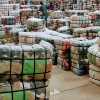BARD AI
JF-Expert Member
- Jul 24, 2018
- 3,376
- 8,120
Uamuzi huo umefikiwa na Mawaziri wa Nchi za Afrika, baada ya Mkutano wa pili uliofanyika jijini Nairobi ikiwa ni utekelezaji wa matakwa ya Eneo Huru la Biashara la Bara la Afrika (AfCFTA).
Katibu Mkuu wa AfCFTA, Wamkele Mene, amesema uamuzi wa kuzuia biashara ya mitumba ni hatua muhimu ya kuhimiza Uongezaji Thamani na Maendeleo ya Viwanda pamoja na kuhakikisha Afrika haiwi jalala la nguo za Mtumba kutoka nje.
Hii ni mara ya pili kufanyika makubaliano haya, mwaka 2015 Mawaziri wa Jumuiya ya Afrika Mashariki (EAC) walizuia biashara hiyo lakini utekelezaji wake haukufanyika. Nchi ya Rwanda pekee imefanikiwa kuzuia biashara hiyo.
Una maoni gani kuhusu uamuzi huu?
==============
African ministers, on June 1, adopted the protocol that prevents trading second-hand clothes across the continent under the preferences of the African Continental Free Trade Area (AfCFTA).
The decision was taken during the second Ministerial Retreat of the Council of Ministers on the AfCFTA, held in Nairobi, Kenya, to assess the progress and address critical aspects of the agreement’s implementation.
Held under the theme “The Role of the Private Sector in the Implementation of the AfCFTA: Own and Drive AfCFTA,” they discussed the outstanding Rules of Origin on Auto, Textiles and Clothing, estimated tariff revenue losses and the adjustment facility allocations, as well as proposals on front-loading liberalisation of trade in basic agricultural products.
Wamkele Mene, Secretary General of AfCFTA, said that the decision to prevent the trade of second-hand clothes is an important step to encourage value-addition and industrialisation in Africa.
“The decision of the Council of Ministers is a strong message that our single market will not be used as a dumping ground for used clothes coming from outside Africa,” he said.
More importantly, Mene noted that it will significantly protect the African textile industries and promote investment in that critical sector.
In most cases, raw materials for garments are sourced in Africa, manufactured in the northern hemisphere, and when the final product is discarded, it is sent back to Africa as goodwill and due to the quality of garments made from first fashion, the clothing is returned to Africa as waste.
This is not the first time Africans take this move. For instance, in 2015, the East African Community (EAC) Heads of State adopted a three-year gradual process to phase out the importation of second-hand clothes and footwear.
It was deemed to make EAC textile and leather factories self-sufficient to serve the local and international markets, including the African Growth and Opportunity Act (AGOA) market which had kept the window wide open for African exports into the American market the same year.
At that time, EAC accounted for 13 percent of global imports of used clothing amounting to $274m (approx. Rwf271 billion)
Despite other EAC member countries rescinding on the decision at a later stage due to the US action of removing these countries from accessing the duty-free AGOA market, Rwanda kept a firm stance.
From there on, Rwanda deliberated on a strategy to develop the textiles, apparel and leather industrial sectors and a blueprint was consequently designed on how to implement such a strategy.
The country put in place a Made-in-Rwanda strategy to boost domestic production and stimulate local consumption habits, which has gained momentum up to now with more Rwandans styling their locally manufactured attire at different occasions.
However, the question remains on meeting the affordability and quality improvement of products from local textile industries.
NEWTIMES.RW
